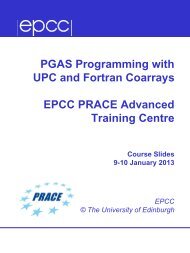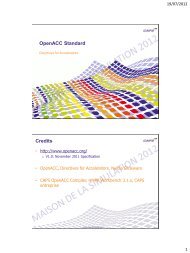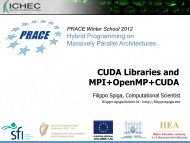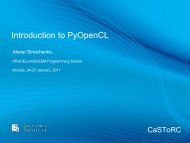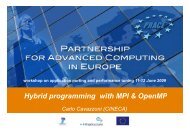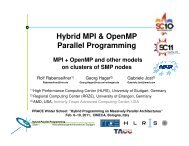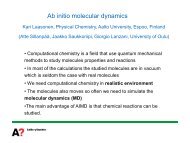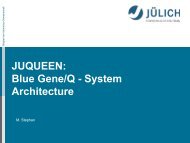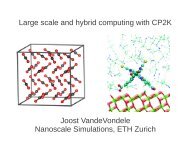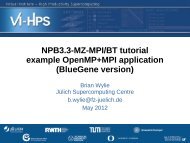Molecular Simulation Methods with Gromacs
Molecular Simulation Methods with Gromacs
Molecular Simulation Methods with Gromacs
Create successful ePaper yourself
Turn your PDF publications into a flip-book with our unique Google optimized e-Paper software.
To run, we’ll create a set of batch-submittable run scripts. The exact settings to use inthe batch system settings (usually #PBS or #SBATCH depending on the batch system inuse) fields depends strongly on the system you’re running on, so the example hereprobably won’t work.#!/bin/sh#SBATCH -J fe#SBATCH -e run1.stderr#SBATCH -o run1.stdout#SBATCH --mem-per-cpu=1000#SBATCH -t 00:10:00# One node of 12 cores per job:#SBATCH -N 1#SBATCH -n 12module load gromacs( cd lambda_0; mdrun -nt 4 >& run.log ) &( cd lambda_01; mdrun -nt 4 >& run.log ) &( cd lambda_02; mdrun -nt 4 >& run.log ) &wait # wait for all background tasks to finishwhich will run three 4-threaded (set <strong>with</strong> -nt 4) versions of mdrun, each in their owndirectory, for a maximum of 10 minutes. Make as many of these scripts as needed for allthe different !-values (i.e. 3), and submit them to the queue.Post-processing: extracting the free energyAfter the simulations are done, we can extract the full free energy difference from theoutput data. Check your directories lambda_00 to lambda_06 for files calleddhdl.xvg. These contain the energy differences that are going to be used to calculatethe free energy difference. Combine them into a free energy <strong>with</strong> the <strong>Gromacs</strong> BAR toolg_bar:g_bar -b 100 -f lambda_*/dhdl.xvgWhere the -b 100 means that the first 100 ps should be disregarded: they serve asanother equilibration, this time at the conditions of the simulation. You should get a freeenergy difference of approximately -17.8 +/- 3.3 kJ/mol (this may be different if you runon different hardware: this answer is from a standard x86_64 cluster). This should becompared to an experimental value of -20.9 kJ/mol.Question: Longer runs will bring the free energy closer to -19.1 +/- 0.3 kJ/mol.Why is there a significant (i.e. bigger than the estimated error) differencebetween the experimental result and the simulation result? How could this beimproved?



